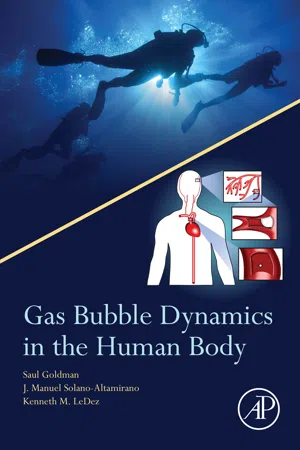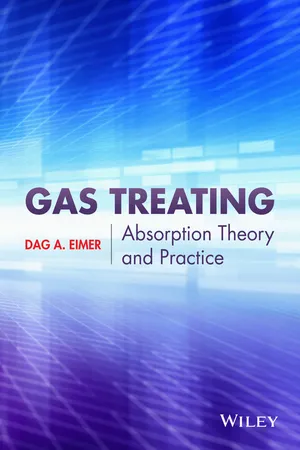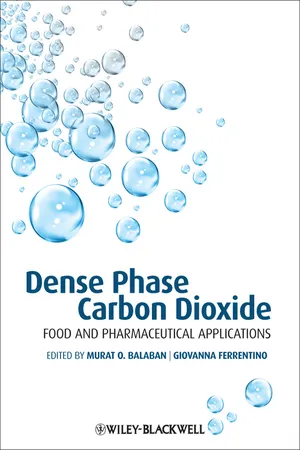Chemistry
Gas Solubility
Gas solubility refers to the ability of a gas to dissolve in a liquid. It is influenced by factors such as temperature, pressure, and the nature of the gas and liquid. Henry's law describes the relationship between the pressure of the gas and its solubility in the liquid, with higher pressures leading to greater solubility.
Written by Perlego with AI-assistance
Related key terms
Related key terms
1 of 4
Related key terms
1 of 3
5 Key excerpts on "Gas Solubility"
- eBook - ePub
- Britannica Educational Publishing, Erik Gregersen(Authors)
- 2010(Publication Date)
- Britannica Educational Publishing(Publisher)
CHAPTER 5 LIQUID SOLUTIONS AND SOLUBILITYT he ability of liquids to dissolve solids, other liquids, or gases has long been recognized as one of the fundamental phenomena of nature encountered in daily life. The practical importance of solutions and the need to understand their properties have challenged numerous writers since the Ionian philosophers and Aristotle. Many physicists and chemists have devoted themselves to a study of solutions.A solution is a mixture of two or more chemically distinct substances that is said to be homogeneous on the molecular scale—the composition at any one point in the mixture is the same as that at any other point. This is in contrast to a suspension (or slurry), in which small discontinuous particles are surrounded by a continuous fluid. Although the word solution is commonly applied to the liquid state of matter, solutions of solids and gases are also possible. Brass, for example, is a solution of copper and zinc, and air is a solution primarily of oxygen and nitrogen with a few other gases present in relatively small amounts.The ability of one substance to dissolve another depends always on the chemical nature of the substances, frequently on the temperature, and occasionally on the pressure. Water, for example, readily dissolves methyl alcohol but does not dissolve mercury; it barely dissolves benzene at room temperature but does so increasingly as the temperature rises. While the solubility in water of the gases present in air is extremely small at atmospheric pressure, it becomes appreciable at high pressures where, in many cases, the solubility of a gas is (approximately) proportional to its pressure. Thus, a diver breathes air (four-fifths nitrogen) at a pressure corresponding to the pressure around him, and, as he goes deeper, more air dissolves in his blood. If he ascends rapidly, the solubility of the gases decreases so that they leave his blood suddenly, forming bubbles in the blood vessels. This condition (known as the bends) is extremely painful and may cause death; it can be alleviated by breathing, instead of air, a mixture of helium and oxygen because the solubility of helium in blood is much lower than that of nitrogen. - eBook - ePub
Environmental Engineering
Principles and Practice
- Richard O. Mines(Author)
- 2014(Publication Date)
- Wiley-Blackwell(Publisher)
The carbonate system is the most important natural buffering system encountered in environmental engineering. It is directly related to alkalinity, which is defined as the buffering capacity of a water to resist a change in pH when an acid is added.- Alkalinity is measured by titrating a sample of water with to a pH of approximately 4.5.
- Mathematically, alkalinity is defined by the following equation:
Liquid-solid species that are partially soluble or insoluble can be explained using the solubility product The solubility of most substances increases with temperature; however, there are exceptions:- Salts with low values generally have low solubilities.
- It is impossible to predict the solubilities of various compounds solely based on values since solids that dissolve into two or three ions will generally have higher solubilities.
Proper application of gas phase laws is essential for designing gas transfer systems, gas strippers, determining saturation concentration of dissolved gases in aqueous solutions, and understanding the relationship between pressure and volume of a gas and between temperature and volume of a gas.- The ideal gas law is used to solve for pressure, volume, moles, or temperature, given three of these four parameters.
- Dalton's law of partial pressure states that the total pressure exerted by a mixture of gases is the sum of the partial pressures of each gas present.
- Raoult's law relates the partial pressure of the gaseous component present above a liquid to the vapor pressure of the pure component and the mole fraction of the pure component in the liquid phase.
- Henry's law is used for calculating the solubility of a gas in a liquid, or to describe the equilibrium condition between the gas and liquid phases.
- There are several forms of Henry's law, so special attention should be placed on the dimensions on the Henry's law constant in order to apply the appropriate equation expressing Henry's law.
Organic chemistry is the study of carbon-containing compounds and their properties. Organic compounds are important because: they form the basis of all life; they are used in the production of pesticides, herbicides, insecticides, polymers, antibiotics, hormones, and alcohols; and they cause detrimental affects to the environment, since many of them are toxic and/or carcinogenic. - eBook - ePub
- Saul Goldman, Manuel Solano-Altamirano, Kenneth Ledez(Authors)
- 2017(Publication Date)
- Academic Press(Publisher)
2Driving force of gas-bubble growth and dissolution
Abstract
Solubility, saturation, supersaturation, and undersaturation are all explained in the context of gas-liquid solutions. Solutions composed both of one and several different gaseous solutes are considered. The chemical potential of a specific chemical species is introduced and its basic role in solute distribution is described. Solute distribution or redistribution occurs so as to lower the value of its chemical potential, because doing so lowers the system free energy. This is made manifest within a single phase by solutes tending to spontaneously diffuse down their concentration gradients, from higher to lower concentrations. For a pair of contiguous phases, such as a gas and a liquid, the tendency to lower the system free energy causes the volatile solute to be driven from the phase in which its chemical potential is larger to the phase in which it is lower. The crucial role of surface tension on gas bubble pressure is described. It is particularly important for small gas bubbles (<50 μ), and it is expressed quantitatively by the Young-Laplace equation. Surface tension tends to increase the pressure acting on the contents of a gas bubble beyond what it would be from the effect of ambient hydrostatic pressure only.Keywords
Chemical potential; Gas Solubility; Surface tension; Supersaturation; Undersaturationδ (ε − Tη + pV ) = 0The condition of stable equilibrium is that the value of the expression in the parenthesis shall be a minimum. J.W. GibbsMain Topics• Solubility• Solute flow• Ideal gas law• Surface tension• Saturation• Supersaturation• UndersaturationMedical Matters• The medical/physical dichotomy2.1 Introduction
Most of this book is about the dynamics of gas-bubble growth and dissolution in the body, and its practical implications for diving and clinical practice. Our orientation is more physical than is typical, and this includes a greater than usual emphasis on providing the physical basis of the underlying phenomena, at a state-of-the-art level. This, in turn, requires some separation of the “basic stuff,” from much of the medical and physiological complexity that accompanies these phenomena. Therefore, in order to set out the physical principles as cleanly and clearly as we can we will, in the chapters that deal largely with physical principles (Chapters 2 –6 and 8 - eBook - ePub
Gas Treating
Absorption Theory and Practice
- Dag Eimer(Author)
- 2014(Publication Date)
- Wiley(Publisher)
2 approaches 0. However, it will be a good approximation for partial pressures up to say 10 bar at least for the temperature shown. It is an absolute must to recognise the limitations of approximations used. They should always be checked.5.5.2 Gas Solubilities
Gases are in general not very soluble in liquids as long as there is no chemical reaction involved. How much that may be dissolved will increase with the gas pressure over the solution and decrease when the temperature is increased. This should be clear from the previous section. There are a number of ways that Gas Solubility may be expressed. It is useful to know of them because they are all used in various encyclopedias of physical data.Henry's law and its various possible forms have been described earlier. Adding the choice of pressure units to those means that there are many ways in which data may be reported. Attention must be paid to units.The Bunsen coefficient is another. This is defined the volume of gas, as if it was at 0°C and 1 atm, dissolved per unit volume of solvent at the system temperature when the partial pressure of the gas is 1 atm.An alternative variation on this concept is the Ostwald coefficient. This is defined as the volume of gas at the system temperature and its partial pressure dissolved in a unit volume of the solvent at the system temperature.Unfortunately the source of data will sometimes leave you to guess. In such cases it is useful to know the probable alternatives. Obviously the use of such data must be with care and preferably considering the effects of alternative guesses. Remember that not all reported data are to the standard of the best learned journals.5.5.3 Raoult's Law
Raoult's law deals with the other end of concentrations, namely nearly pure liquids. It states that the partial pressure of a component is proportional to its concentration: - eBook - ePub
Dense Phase Carbon Dioxide
Food and Pharmaceutical Applications
- Murat O. Balaban, Giovanna Ferrentino, Murat O. Balaban, Giovanna Ferrentino(Authors)
- 2012(Publication Date)
- Wiley-Blackwell(Publisher)
3 Experimental Measurement of Carbon Dioxide SolubilityGiovanna Ferrentino, Thelma Calix, Massimo Poletto, Giovanna Ferrari, and Murat O. BalabanAbstract: The application of dense phase carbon dioxide for the pasteurization of liquid foods has fostered research in the study of the phase behavior of systems in which CO2 is in contact with liquid foods of different compositions in different processing conditions of pressure and temperature. CO2 solubility in liquid phase is the key parameter for proper design of these processes. In this chapter, a review of the systems designed to experimentally measure CO2 solubility and the resulting experimental data are reported starting from the results of CO2 solubility in water and continuing with more complex aqueous solutions.Keywords: CO2 solubility; experimental systems; thermodynamic modeling.3.1 Introduction
Solubility of gases in liquids has been studied since the nineteenth century (Battino and Clever 1965; King et al. 1992). The solubility of a solute is the analytical composition of a saturated solution, expressed in terms of the proportion of the designated solute in a designated solvent (Karukstis and Van Hecke 2000). Knowledge of carbon dioxide (CO2 ) solubility and its phase behavior in different solutions is important considering the diverse applications in which CO2 is involved.The phase behavior of fluid mixtures can be determined experimentally with the design of suitable experimental systems, and theoretically with the application of thermodynamic models. The direct measurement of phase equilibrium data remains the most important source of reliable information despite the difficulty and expense of precise measurements since, with the exception of simple systems, theoretical and numerical models are not fully predictive. However, they provide a great help by significantly reducing the number of experimental data points needed to characterize the thermodynamic behavior of an unknown system. In general, the design of the experimental setup is critical in determining the reliability of the measurement procedures.
Index pages curate the most relevant extracts from our library of academic textbooks. They’ve been created using an in-house natural language model (NLM), each adding context and meaning to key research topics.
Explore more topic indexes
Explore more topic indexes
1 of 6
Explore more topic indexes
1 of 4




